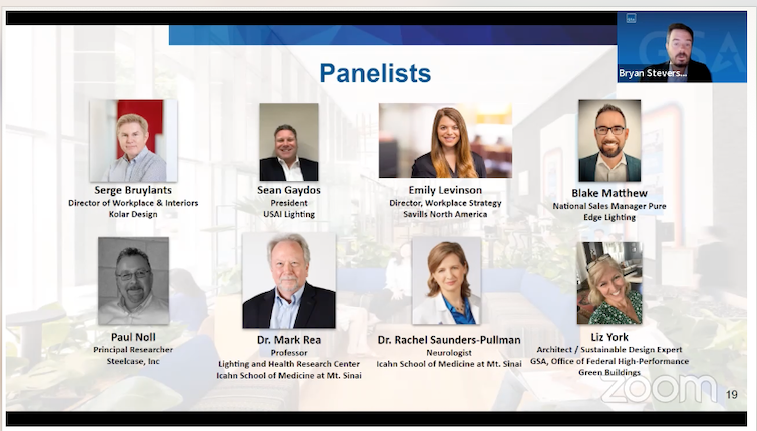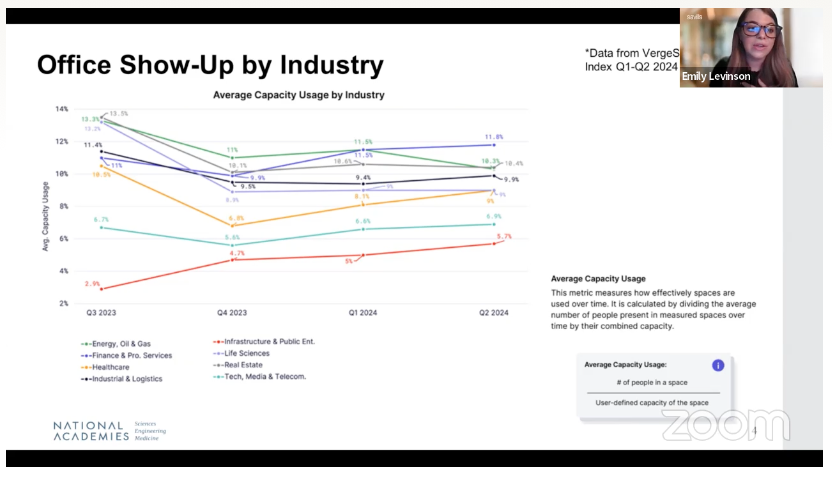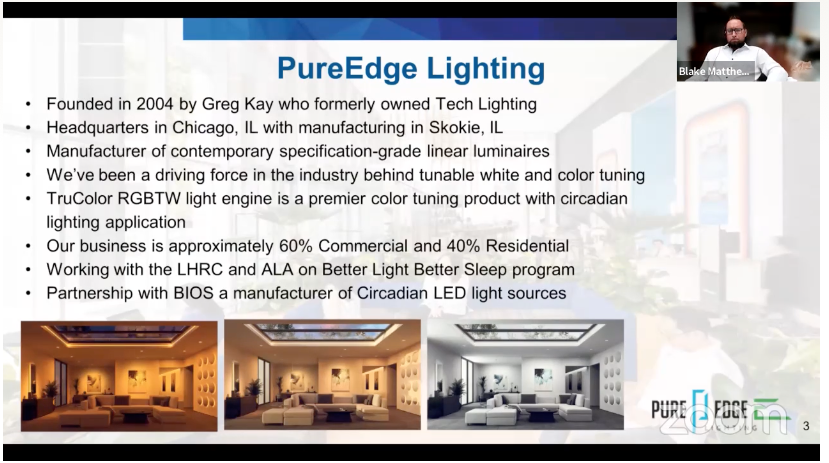Advancing Circadian Lighting in Modern Workspaces: Insights from the GSA and Health in Buildings Roundtable
On 20 August, experts from across the country gathered for the National Academies’ GSA/Health in Buildings Roundtable: Circadian-Effective Lighting event. This workshop, led by Bryan Steverson of the General Services Administration (GSA), brought together industry leaders, lighting experts, and researchers to discuss the challenges and opportunities in implementing circadian-effective lighting in commercial office environments.

Conference Panelists:
- Bryan Steverson, Office of Federal High-Performance Green Buildings, General Services Administration (GSA)
- Serge Bruylants, Director of Workplace & Interiors, Kolar Design
- Sean Gaydos, President, USAI Lighting
- Emily Levinson, Director of Workplace Strategy, Savills North America
- Blake Matthew, National Sales Manager, Pure Edge Lighting
- Paul Noll, Principal Researcher, Steelcase, Inc.
- Dr. Mark Rea, Professor, Lighting and Health Research Center, Icahn School of Medicine at Mt. Sinai
- Dr. Rachel Saunders-Pullman, Neurologist, Icahn School of Medicine at Mt. Sinai
- Liz York, Architect and Sustainable Design Expert, Office of Federal High-Performance Green Buildings, GSA
Setting the Stage: The Importance of Circadian Lighting
For decades, the primary focus of lighting design has been on visual performance—ensuring enough illumination for tasks like reading, working, and collaborating. However, new research reveals that lighting’s influence extends beyond visual needs and is critical in aligning our biological clocks with the natural light-dark cycle. When this alignment is disrupted, it can lead to poor sleep, diminished daytime performance, and even long-term health risks.
Dr. Mark Rea emphasized, “The science is clear—getting the right amount of light at the right time is essential for maintaining our internal clocks and overall well-being. Whether we measure that light in lux, lumens, or another metric is less important than ensuring people understand how to achieve healthy lighting.”
Dr. Rachel Saunders-Pullman added, “In clinical settings, circadian lighting has shown measurable improvements in mood, sleep, and even cognitive function for patients with neurodegenerative conditions like Alzheimer’s and Parkinson’s disease. These benefits extend beyond clinical spaces, impacting general well-being in everyday environments.”
The Disconnect: Energy Codes vs. Circadian Lighting
Despite mounting scientific evidence supporting the benefits of circadian lighting, building designs are still primarily guided by energy codes and lighting recommendations focused solely on visual performance. This disconnect between research and practice remains a significant barrier to implementing circadian-effective solutions in commercial buildings.
Bryan Steverson from the GSA noted, “We need a balanced approach that prioritizes energy efficiency and human health. This roundtable is a first step in aligning stakeholders—from researchers and manufacturers to building owners and healthcare professionals—to find common ground in addressing these challenges.”
Liz York emphasized the evolving mission at GSA: “Historically, building design was centered around mitigating risks like asbestos. Now, we’re expanding our focus to enhance occupant health actively. Given that most Americans spend 90% of their time indoors, and with workplace-related health issues costing billions annually, the opportunity to redefine how we design and manage our spaces has never been greater.”
Insights from GSA: Promoting Health in Building Design
The GSA, which manages over 370 million square feet of federal office space, has already researched how to better understand the relationship between lighting and health. Early studies focused on daylighting exposure, revealing strong correlations between light exposure and improved sleep, alertness, and mood. More recent research has incorporated electric lighting to determine if similar benefits can be achieved in spaces with limited access to natural light.
“The results are promising,” said Paul Noll from Steelcase, Inc. “We’ve seen that by using well-timed electric lighting in spaces without natural daylight, we can replicate the positive outcomes associated with daylight exposure. This includes better sleep quality, increased alertness, and improved mood.”
Sean Gaydos of USAI Lighting pointed out, “The challenge lies in designing lighting systems that meet both energy codes and circadian needs. The complexity is often overestimated, leading to missed opportunities to implement effective solutions. Our goal is to demonstrate that circadian lighting can be simple, scalable, and cost-effective.”
Overcoming Barriers: Collaboration and Simplification
A recurring theme throughout the discussion was the need for collaboration and simplification. Attendees highlighted the importance of clear, actionable guidelines that designers, building owners, and end-users can easily communicate and apply.
Dr. Mark Rea reiterated, “Let’s stop overcomplicating things. The key is to deliver the right light at the right time. Whether you choose to measure it using melanopic lux, EDI (Equivalent Daylight Illuminance), or even just basic illuminance is less important than ensuring the message is accessible.”
Liz York echoed this sentiment, “Education and clear communication are critical. We need to move past the technical jargon and focus on making the benefits of circadian lighting tangible for both industry professionals and the general public.”
Balancing Control, Choice, and Functionality in Office Lighting Design

In addition to scientific insights, the roundtable explored how lighting design can cater to user needs in modern office environments. Emily Levinson of Savills North America highlighted the importance of giving employees control over their lighting. “Employees today want environments that adapt to their preferences and tasks. The rise of automated systems has improved energy efficiency but often at the expense of personal control. Balancing automation with user choice is essential for creating satisfying workspaces.”

Blake Matthew from Pure Edge Lighting added, “We’re seeing a shift in office design towards more open layouts and shared spaces. The challenge is incorporating flexible lighting solutions that can adapt to different work modes and occupancy levels. Lighting should enhance visual comfort and the overall workplace experience.”
Looking Forward: The Future of Circadian Lighting in Workplace Design
The workshop concluded with a discussion on the future of circadian lighting and how to drive broader adoption in both commercial and residential settings. Attendees agreed that the key to success lies in education, collaboration, and simplifying the approach for all stakeholders involved.
Dr. Rachel Saunders-Pullman suggested, “For widespread adoption, we need to bridge the gap between research and real-world application. This involves creating practical, evidence-based guidelines that are easy to understand and implement across different environments.”
Looking ahead, the Health in Buildings Roundtable aims to refine its recommendations and continue promoting scalable solutions that enhance both occupant health and productivity. As Liz York noted in her closing remarks, “Our goal is to create environments where people leave feeling better than when they arrived—whether they’re in a healthcare facility, a workplace, or their own homes.”




